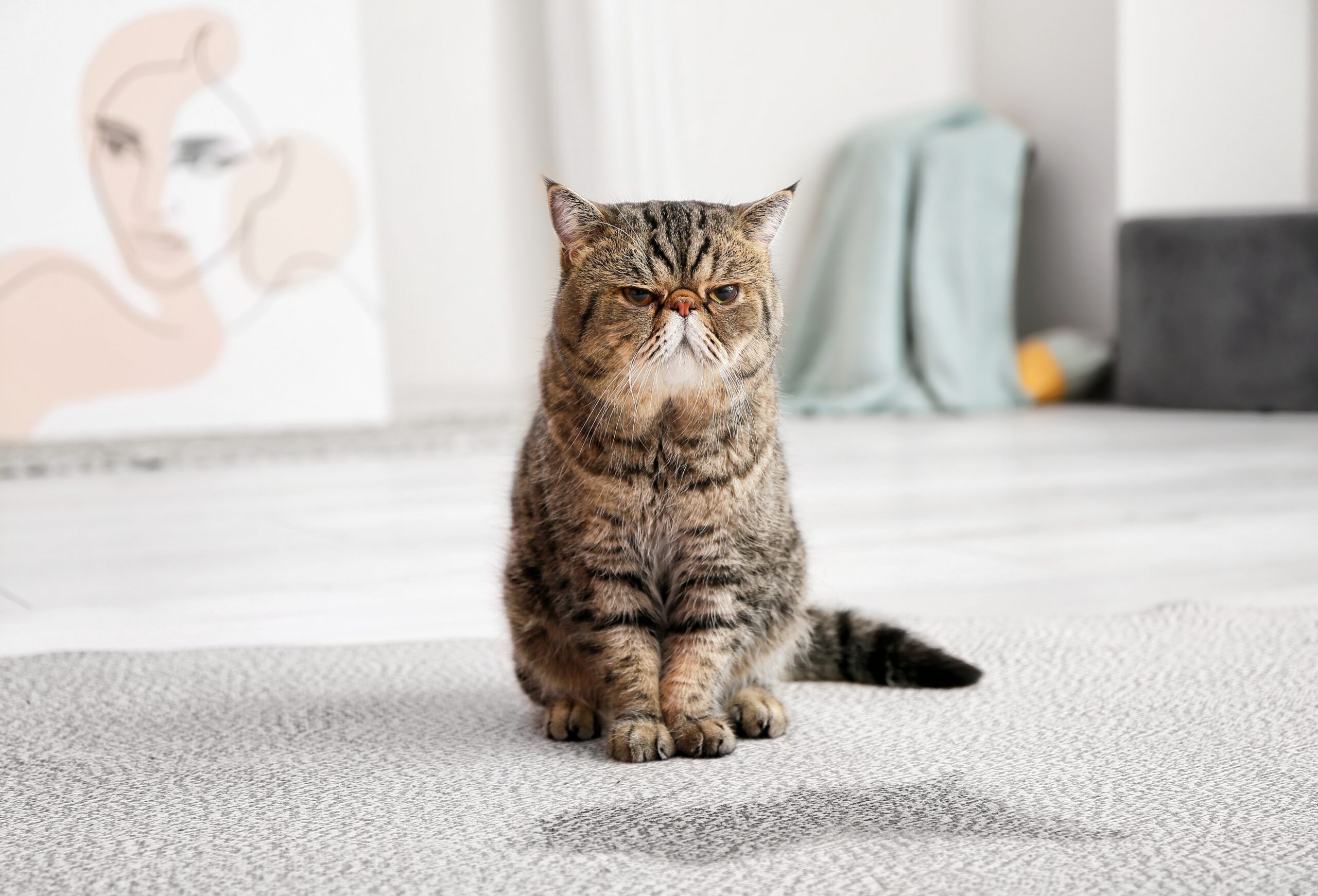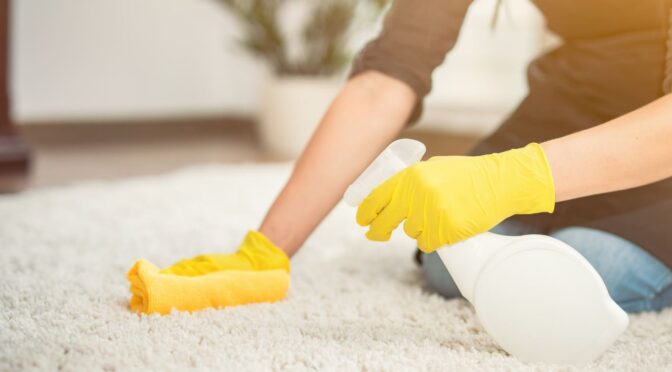Removing pet stains is an all-too-common task for pet owners, especially in homes with furry friends who haven’t quite mastered the art of outdoor relief or are prone to the occasional accident. The wrong pet-safe cleaning products can turn a minor stain into a major hassle, leading to lingering odours, carpet damage, or even adverse effects on pets’ health. Knowing what to avoid can be just as crucial as knowing what to use. This guide outlines the products to avoid for pet stain removal and provides insights into why they’re more harmful than helpful.
1. Bleach
Why to Avoid It: Bleach is a powerful disinfectant, but it’s far from suitable for pet stain removal. While it might seem like an easy solution for eliminating bacteria, bleach can damage fabrics and carpets, stripping colour and potentially weakening fibres. Furthermore, bleach is highly toxic to animals. Inhaling fumes or coming into direct contact with bleach can cause respiratory issues, skin burns, and even poisoning in pets.
Alternative: Use enzymatic cleaner for pet stains specially designed to break down pet urine and organic stains. These are safe for most fabrics and floors and are formulated to tackle both the stain and the lingering odour.
2. Ammonia-Based Cleaners
Why to Avoid It: Ammonia is a common ingredient in household cleaners and disinfectants, but it’s unsuitable for pet stain removal. Pet urine contains ammonia-like compounds, so using an ammonia-based cleaner can actually attract your pet back to the same spot, encouraging repeated accidents. Additionally, ammonia’s strong scent can be overwhelming for both pets and humans, potentially irritating the respiratory system.

Alternative: Opt for a cleaner that neutralises odours without the use of ammonia. Enzymatic cleaner for pet stains are ideal for this, as they break down the odour-causing bacteria instead of masking the scent.
3. Vinegar
Why to Avoid It: Vinegar is often touted as an all-natural cleaning solution. However, when it comes to pet stain removal, vinegar is more problematic than productive. The acidic nature of vinegar doesn’t pair well with alkaline pet urine, as it can cause the stain to set further into the fabric. This can make the stain tougher to remove and might leave behind a faint scent that pets can pick up on, encouraging them to revisit the area.
Alternative: For a natural alternative, use baking soda as a pre-treatment. It absorbs moisture and can help with initial odour control before applying a more effective enzymatic cleaner for pet stains.
4. Hydrogen Peroxide
Why to Avoid It: Hydrogen peroxide is a common household antiseptic, but it’s not suited for pet stain removal on carpets or fabrics. At higher concentrations, hydrogen peroxide can bleach or discolour carpets and fabrics, leaving an unsightly patch where the stain used to be. While it has sanitising properties, it doesn’t tackle the core issue of pet stains: breaking down the uric acid and other compounds that cause odours.

Alternative: Stick to pet-safe cleaning products specifically labelled for pet stain removal, as these are formulated to break down the specific compounds found in pet urine and faeces.
5. Dish Soap or Laundry Detergent
Why to Avoid It: While dish soap and laundry detergents might seem like easy go-to solutions, they’re not designed for use on pet stains. These soaps can leave a residue on carpets and fabrics, trapping the odour instead of removing it. Additionally, many detergents contain fragrances and chemicals that are irritating to pets, leading to allergic reactions or skin issues if they come into contact with the residue.
Alternative: Consider a low-residue carpet shampoo or pet-safe cleaning products. These are formulated to clean without leaving behind the kind of residue that attracts dirt and pet dander.
6. Carpet Deodorisers and Fresheners
Why to Avoid It: Carpet deodorisers and fresheners are primarily designed to mask odours rather than eliminate them. When dealing with pet stains, the source of the odour needs to be broken down, not covered up. Additionally, many deodorisers contain artificial fragrances and chemicals that may be harmful to pets, especially if they like to lay or play in the same area.
Alternative: Look for odour eliminators that use natural ingredients or enzymatic processes to remove the smell at its source. These products are typically safer for pets and more effective for long-term odour control.
7. Baking Soda and Peroxide Mixes
Why to Avoid It: A popular DIY cleaning hack for various stains, mixing baking soda and hydrogen peroxide may initially lift some stains, but it’s not ideal for pet stains. The bubbling effect of hydrogen peroxide with baking soda can bleach or discolour fabrics, and it doesn’t fully remove the organic compounds found in pet stains. Additionally, the abrasive nature of baking soda might damage certain carpet fibres over time.

Alternative: Use baking soda alone as a pre-treatment to absorb moisture and odour. For deeper cleaning, follow up with a high-quality enzymatic cleaner for pet stains.
8. Essential Oils
Why to Avoid It: Essential oils have become a trendy cleaning solution, but many essential oils, like tea tree, peppermint, and citrus, are toxic to pets. While these oils might provide a pleasant smell, their concentration levels can pose significant risks to animals, including respiratory issues, allergic reactions, or even poisoning.
Alternative: Stick to pet-safe cleaning products specifically formulated for use around animals. These products avoid the use of toxic essential oils and instead rely on pet-friendly ingredients.
9. Steam Cleaners
Why to Avoid It: Steam cleaners are effective at cleaning carpets and other fabrics, but they’re not ideal for pet stains. The high heat can actually set stains and odours, making them more challenging to remove. Heat can also cause any residual bacteria or proteins from the stain to bind more strongly to the carpet fibres.
Alternative: A better approach is to use cold water and a blotting technique to absorb as much of the stain as possible. Then, follow up with a targeted pet-safe cleaning products. If a deep clean is needed, consider a cold-water carpet cleaner that uses a pet-safe solution.
10. High-Residue Shampoos
Why to Avoid It: Some carpet shampoos and cleaners leave a residue that can attract dirt and trap odours, leading to quicker re-soiling and lingering smells. High-residue products don’t fully break down the organic materials in pet stains, leading to unsatisfactory results and encouraging repeated use, which can be harmful in the long run.
Alternative: Choose a low-residue, pet-safe cleaning products, or hire a professional cleaning service that uses residue-free products. This will help keep carpets cleaner for longer and reduce the likelihood of repeat incidents.
11. General Household Cleaners
Why to Avoid It: Many general-purpose cleaners contain chemicals that are too harsh for fabrics and carpets, and some of these ingredients can be harmful or even toxic to pets. Products containing bleach, ammonia, and artificial fragrances can all have adverse effects on both the stain and the health of your pets. Furthermore, general-purpose cleaners aren’t formulated to tackle the specific composition of pet stains, so they’re often ineffective.
Alternative: Always use pet-safe cleaning products specifically labelled for pet stain removal. These are formulated with pet safety in mind and have the enzymes needed to break down the organic compounds in pet stains.
FAQs about Products Should You Avoid Using for Pet Stain Removal?
- What is the best way to remove pet stains from carpets?
The best way to remove pet stains is to use an enzymatic cleaner specifically designed for pet stains, as it breaks down the organic compounds in urine and faeces, neutralising odours at the source. - Why should I avoid using bleach on pet stains?
Bleach is not recommended for pet stains because it can damage carpet fibres, cause discolouration, and emit harmful fumes that are dangerous to both pets and humans. - Are ammonia-based cleaners safe for removing pet stains?
No, ammonia-based cleaners can actually encourage pets to return to the spot due to the ammonia-like compounds in pet urine. They can also cause respiratory irritation. - Can I use vinegar to clean pet urine stains?
Vinegar is not ideal for pet urine stains as it can set the stain further and may leave an odour that encourages pets to revisit the spot. - What are enzymatic cleaners, and why are they recommended for pet stains?
Enzymatic cleaners contain natural enzymes that break down the organic compounds in pet urine and faeces, effectively neutralising both the stain and odour. - Why is it important to avoid essential oils in pet stain removers?
Essential oils like tea tree and citrus can be toxic to pets, leading to potential health issues if they come into contact with or ingest them. - Are steam cleaners safe to use on pet stains?
Steam cleaners should be avoided for pet stains, as the high heat can set the stain and odour deeper into the fabric, making it harder to remove. - What makes pet-specific cleaners different from general household cleaners?
Pet-specific cleaners are formulated to safely and effectively break down the unique organic compounds in pet stains, whereas general cleaners may not fully remove the odour and could leave harmful residues. - Can hydrogen peroxide remove pet stains effectively?
Hydrogen peroxide can discolour fabrics and doesn’t effectively break down the odour-causing compounds in pet stains, so it’s best avoided for this purpose. - What should I do if a pet stain is particularly stubborn or recurring?
For tough or recurring stains, it’s best to call a professional pet stain removal service. They use specialised products and techniques to completely eliminate the stain and odour.
Don’t let pet stains ruin your home! Get expert help today — call 03 8583 9106, email petstainremovertoday@gmail.com, or visit petstainremover.com.au for safe, effective stain solutions. Make your home fresh and pet-friendly again!





